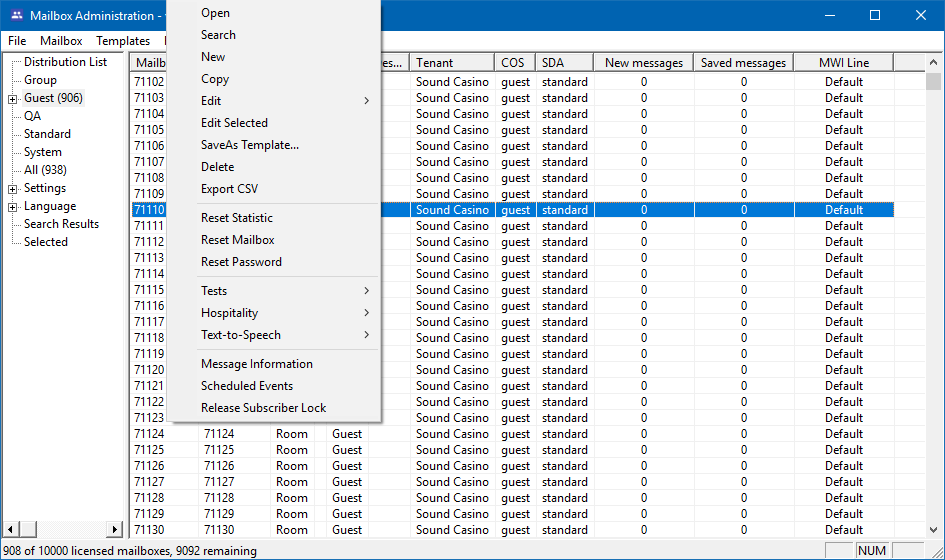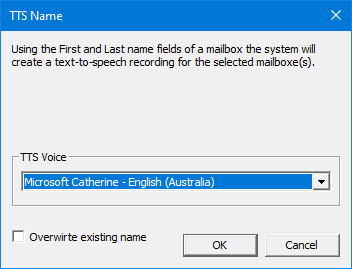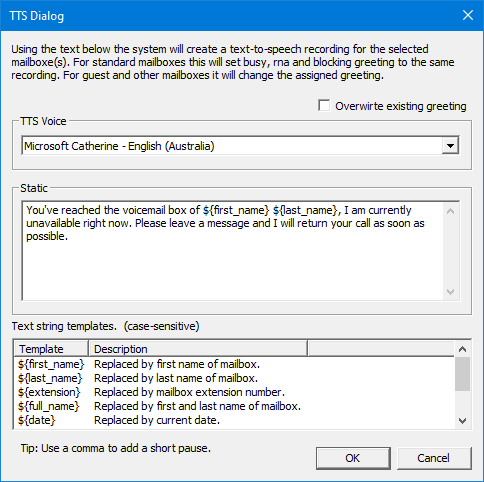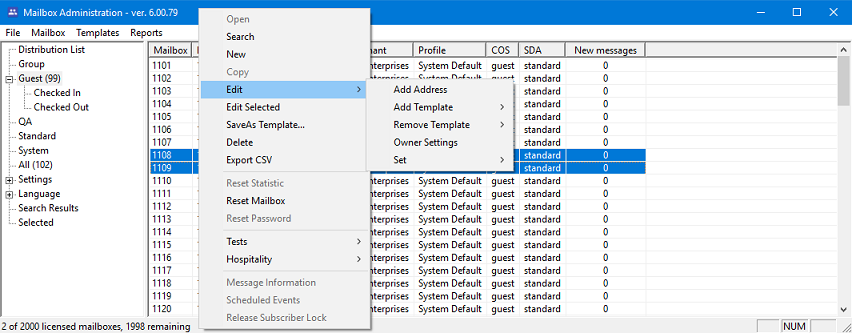Mailbox Administration
Mailbox Administration is the primary application the system administrator will use to configure and manage the 7.00 voice server (VS). It allows you to create, delete and edit both mailboxes and the system templates that are used to modify mailbox behavior. The utility can be accessed by clicking on the Start button and then selecting All Programs | DuVoice | Mailbox Administration (in Windows 7; in other versions of Windows, this may differ).
A shortcut to the utility may be placed on the desktop, in the Start menu, and/or pinned to the taskbar, thereby making the application more readily accessible. Depending on your selections in the Install wizard, shortcuts to System Configuration and other commonly-used applications are placed in the context menu (accessed by right-clicking on the desktop), as shown below:

The context menu may vary depending on the version of Windows installed.
The figure below is an example of what the Mailbox Administration main window may look like:

Category List
The left pane lists a number of different categories (and sub-categories) by which you can filter out all mailboxes except those that fit the selected category. This can be very useful if you want to know which mailboxes are of a particular type, or have a particular setting enabled, without having to search through a list of dozens or even hundreds of mailboxes to find them. Just click on the desired category and the list in the right-hand pane will be refreshed to only display the mailboxes that fit in the selected category.
| Category | Description |
|---|---|
| All | Display all mailboxes. |
| Guest | Only display mailboxes of type guest. Or select one of the sub-categories to filter by checked in or checked out. |
| Standard | Only display mailboxes of type standard. |
| System | Only display mailboxes of type system. |
| Distribution List | Only display mailboxes of type distribution. |
| Group | Only display mailboxes of type group. |
| QA | Only display mailboxes of type QA (Question-and-Answer). |
| Settings | Only display mailboxes that have the given mailbox setting enabled. You can select from the following settings: DND On, Call screening, Tutorial incomplete and Hidden from directory. These settings are generally only applicable to standard mailboxes, not guest mailboxes. So selecting Tutorial incomplete will show you all standard mailboxes where the user has not completed the tutorial. |
| Language | Only display mailboxes that are configured to use the selected language. Only installed, active languages will appear as sub-categories in this list. Default refers to the default language, as set in System Configuration. |
Mailbox List
The right pane displays useful mailbox data for all mailboxes that match the currently-selected category. Each row in the table represents a single mailbox.
| Column | Description |
|---|---|
| Mailbox | The mailbox number. |
| Extension | The physical extension number assigned to the mailbox (also called the Office Extension in the address list). |
| First name | The subscriber's or guest's first name. For all mailbox types except guest and standard, the single name field maps to this column. |
| Last name | The subscriber's or guest's last name. Only used for guest and standard mailboxes. |
| Type | The mailbox type. |
| Description | A custom description field. By default, this field is blank. |
| Tenant | The tenant to which this mailbox is assigned. |
| COS | The class of service template assigned to this mailbox. |
| SDA | The single digit action menu assigned to this mailbox. |
| New messages | The new message count. |
| Saved messages | The saved message count. |
| MWI Line | Line mailbox is assigned to perform message waiting. Typically only used for Avaya PBX's. When set to default any line configured for MWI will be used. |
To change the width of any of the columns, place the mouse pointer to the right of the column so that it changes to the double-arrow pointer, then left-click and drag the mouse left or right to decrease or increase, respectively, the width of the column. Also, you can re-order the columns by left-clicking on the column header and dragging it left or right to a new position. These changes will only remain for the current session; the next time you run Mailbox Administration it will return to the default settings.
Menus
Mailbox Administration menu options are divided into the following categories: File, Mailbox, Templates, and Reports. There is also a right-click context menu
File menu
The File menu provides a single option, to exit the application.
Mailbox menu
The Mailbox menu provides the following options for editing and manipulating mailboxes:

| Option | Description |
|---|---|
| Create | Create a single mailbox. |
| Delete | Delete a single mailbox. |
| Edit | Edit a mailbox using the mailbox editor. |
| Import CSV | Import one or more mailboxes from a comma-separated value (CSV) text file. |
| Import LDAP | Import one or more mailboxes from an LDAP server. |
| Range Create | Create a range of mailboxes using the range creation wizard. |
| Search | Search the mailbox list either by mailbox number or by the subscriber's name, the location or the description. |
| Export CSV | Export one or more mailboxes to a comma-separated value (CSV) text file. |
Templates menu
The Templates menu provides the following options for editing and managing templates:

| Option | Description |
|---|---|
| Call Routing | Defines both pre- and post-processing for calls into the given mailbox. |
| Class of Service | Defines mailbox attributes and subscriber permissions and restrictions. |
| Message Delivery | Defines message forwarding options. |
| Notifications | Defines notification options triggered by certain events (such as receiving a message). |
| Question and Answer | Defines the Q & A script used by a QA mailbox. |
| Scheduled Events | Defines changes to mailbox behavior that occur on a scheduled basis, overriding various mailbox settings (including the active COS and SDA templates). |
| Single Digit Action Codes | Defines user input options available during playback of the mailbox greeting. |
Reports menu
The Reports menu provides the following report options:

| Option | Description |
|---|---|
| Activity | Select from one of four reports:
|
| Emergency Alert | Generate a report for all emergency alerts for one or more extensions, within a specified date range. |
| Guest Rooms | Select from one of three reports:
|
| Mailbox | Select from one of three reports:
|
| System Events | Generates a report of DV2000 service-related activity, such as services starting or shutting down, maintenance activity, and so forth, within a specified date range. |
Context menu
The main window also supports a context menu, accessed by right-clicking on one of the rows or on a selection of multiple rows.
Single Selection
Right-clicking on a single mailbox (row) provides the following options:

| Option | Description |
|---|---|
| Open | Open the selected mailbox for editing. |
| Search | Open the search dialog. |
| New | Open the create mailbox dialog. |
| Copy | Create a new mailbox using the selected mailbox as a template. |
| Edit | Select an option to edit a specific setting without opening the mailbox editor.
|
| Edit Selected | Display all selected mailboxes in the Selected category and then auto-select that category from the left pane. This is a convenience function to simplify comparing and editing a subset of mailboxes. |
| Save as Template | Save the mailbox as configured as a template that can be used when creating a new mailbox. |
| Delete | Delete the selected mailbox. You will be prompted to confirm before the mailbox is actually deleted. |
| Export CSV | Export the selected mailbox to a comma-separated value (CSV) text file. |
| Reset Statistic | Reset the statistics for the mailbox. |
| Reset Mailbox | Reset one or more settings for the mailbox back to a default value. |
| Reset Password | Reset the password to a selected value. |
| Tests | Send a test voice or email message to the mailbox. |
| Hospitality | Perform a hospitality-related action:
|
| Text-to-Speech | Using Microsoft TTS engine, create name and greetings.
|
| Message Information | View message information for the mailbox. |
| Scheduled Events | View currently-scheduled notifications (and other events) for the mailbox. |
| Release Subscriber Lock | Unlock the mailbox if it is locked. This should only be used if the system says the mailbox is in use when you try to log in and you can see that no one is actually logged in. If someone actually is logged in when you select this option, you can cause system instability. |
[1] The Set/Clear DND options will only notify the PBX if there is a configured PBX Link and it supports passing the DND status.
Text-To-Speech
TTS Name
Using the first and last name of the mailbox(s) selected a name is created using text-to-speech.

TTS Greeting
Using this dialog a greeting will be created for the mailbox(s) selected. A simple default text has already been added which be modified for a perfect greeting.

Multiple Selection
Right-clicking on a multiple mailboxes (rows) provides the following options:

As shown in the figure above, some options are disabled because they can only be performed on a single mailbox at a time. Other than New and Search, which do not require a selection at all, the remaining options either are applied automatically to all selected mailboxes or open a dialog that allows you to edit the desired value per-mailbox for any or all of the selected mailboxes.
Aside from that, the options otherwise behave the same as described in the Single Selection section above.